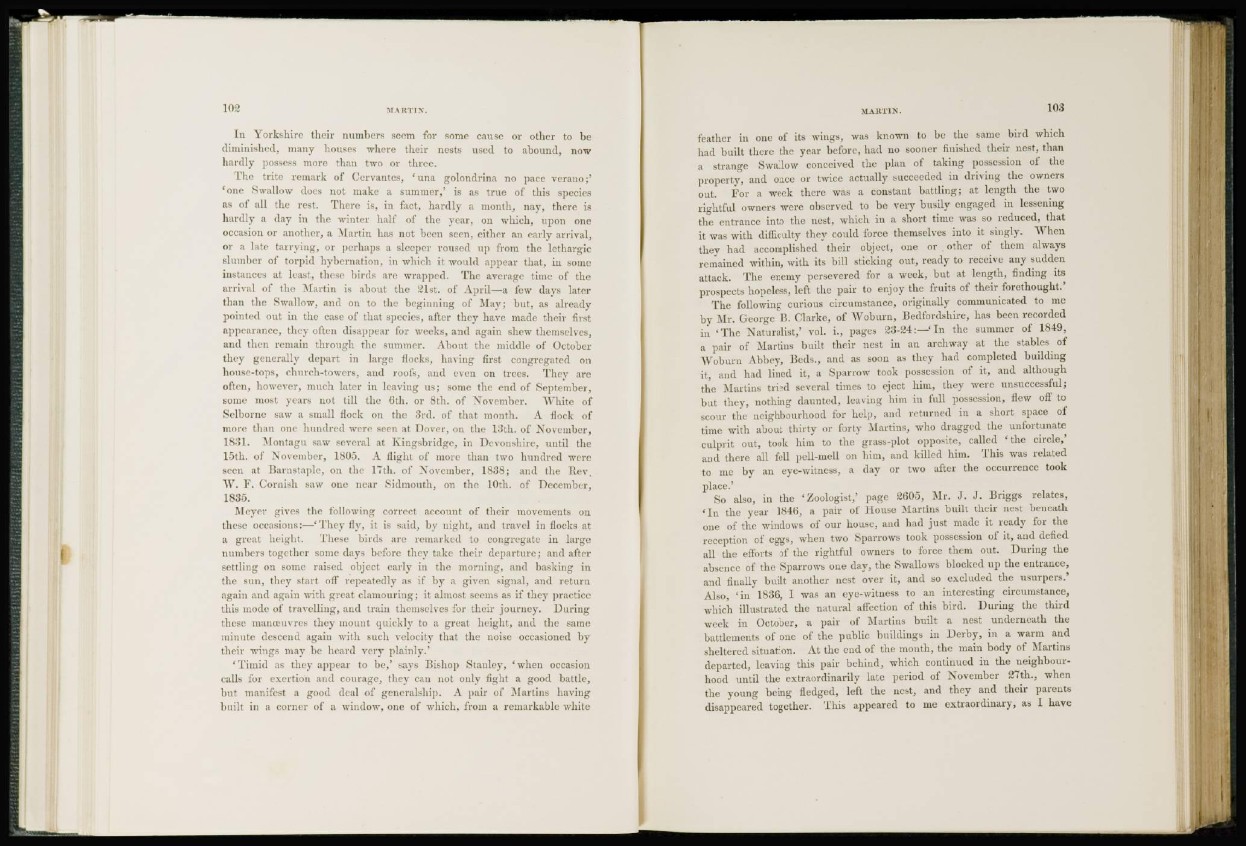
In Yorkshire their numbers seem for some cause or other to be
diminished, many houses where their nests used to abound, now
hardly possess more than two or three.
The trite remark of Cervantes, 'una golondrina no pace vcrano;'
' one Swallow docs not make a summer,' is as true of this species
as of all the rest. There is, in fact, hardly a month, nay, there is
hardly a day in the winter half of the year, on which, upon one
occasion or another, a Martin has not been seen, cither an early arrival,
or a late tarrying, or perhaps a sleeper roused up from the lethargic
slumber of torpid hybernation, in which it would appear that, in some
instances at least, these birds are wrapped. The average time of the
arrival of the Martin is about the 21st. of April—a few days later
than the Swallow, and on to the beginning of May; but, as already
pointed out in the case of that species, after they have1 made their first
appearance, they often disappear for weeks, and again shew themselves,
and then remain through the summer. About the middle of October
they generally depart in large flocks, having first congregated on
house-tops, church-towers, and roofs, and even on trees. They are
often, however, much later in leaving us; some the end of September,
some most years not till the 6th. or 8th. of November. White of
Selborne saw a small nock on the 3rd. of that month. A Hock of
more than one hundred were seen at Dover, on the 13th. of November,
1831. Montagu saw several at Kingsbridge, in Devonshire, until the
loth, of November, 1805. A flight of more than two hundred were
seen at Barnstaple, oa the 17th. of November, 1838; and the Rev,
W. F. Cornish saw one near Sidmouth, on the 10th. of December,
1835.
M ever gives the following correct account of their movements on
these occasions:—'They fly, it is said, by night, and travel in flocks at
a great height. These birds are remarked to congregate in large
numbers together some days before they take their departure; and after
settling on some raised object early in the morning, and basking in
the sun, they start off repeatedly as if by a given signal, and return
again and again with great clamouring; it almost seems as if they practice
this mode of travelling, and train themselves for their journey. During
these manoeuvres they mount quickly to a great height, and the same
minute descend again with such velocity that the noise occasioned by
their wings may be heard very plainly.'
'Timid as they appear to be,' says Bishop Stanley, 'when occasion
calls for exertion and courage, they can not only fight a good battle,
but manifest a good deal of generalship. A pair of Martins having
built in a corner of a window, one of which, from a remarkable white
feather in one of its wings, was known to be the same bird which
had built there the year before, had no sooner finished their nest, than
a strange Swallow conceived the plan of taking possession of the
property, and once or twice actually succeeded in driving the owners
out. For a week there was a constant battling; at length the two
rightful owners were observed to be very busily engaged in lessening
the entrance into the nest, which in a short time was so reduced, that
it was with difficulty they could force themselves into it singly. When
they had accomplished their object, one or other of them always
remained within, with its bill sticking out, ready to receive any sudden
attack. The enemy persevered for a week, but at length, finding its
prospects hopeless, left the pair to enjoy the fruits of their forethought.'
The following curious circumstance, originally communicated to me
by Mr. George B. Clarke, of Woburn, Bedfordshire, has been recorded
in 'The Naturalist,' vol. i., pages 23-24:—'In the summer of 1849,
a pair of Martins built their nest in an archway at the stables of
Woburn Abbey, Beds., and as soon as they had completed building
it, and had lined it, a Sparrow took possession of it, and although
the Martins tried several times to eject him, they were unsuccessful;
but they, nothing daunted, leaving him in full possession, flew off to
scour the neighbourhood for help, and returned in a short space of
time with about thirty or forty Martins, who dragged the unfortunate
culprit out, took him to the grass-plot opposite, called ' the circle,'
and there all fell pell-mell on him, and kUlcd him. This was related
to me by an eye-witness, a day or two after the occurrence took
place.'
So also, in flu; 'Zoologist,'' page 260o, Mr. J. J. Briggs relates,
'In the year 1846, a pair of House Martins built their nest beneath
one of the windows of our house, and had just made it ready for the
reception of eggs, when two Sparrows took possession of it, and defied
all the efforts of the rightful owners to force them out. During the
absence of the Sparrows one day, the Swallows blocked up the entrance,
and finally built another nest over it, and so excluded the usurpers.'
Also, 'in 1836, 1 was an eye-witness to an interesting circumstance,
which illustrated the natural affection of this bird. During the third
week in October, a pair of Martins built a nest underneath the
battlements of one of the public buildings in Derby, in a warm and
sheltered situation. At the end of the month, the main body of Martins
departed, leaving this pair behind, which continued in the neighbourhood
until the extraordinarily late period of November 27th., when
the young being fledged, left the nest, and they and their parents
disappeared together. This appeared to me extraordinary, as 1 have